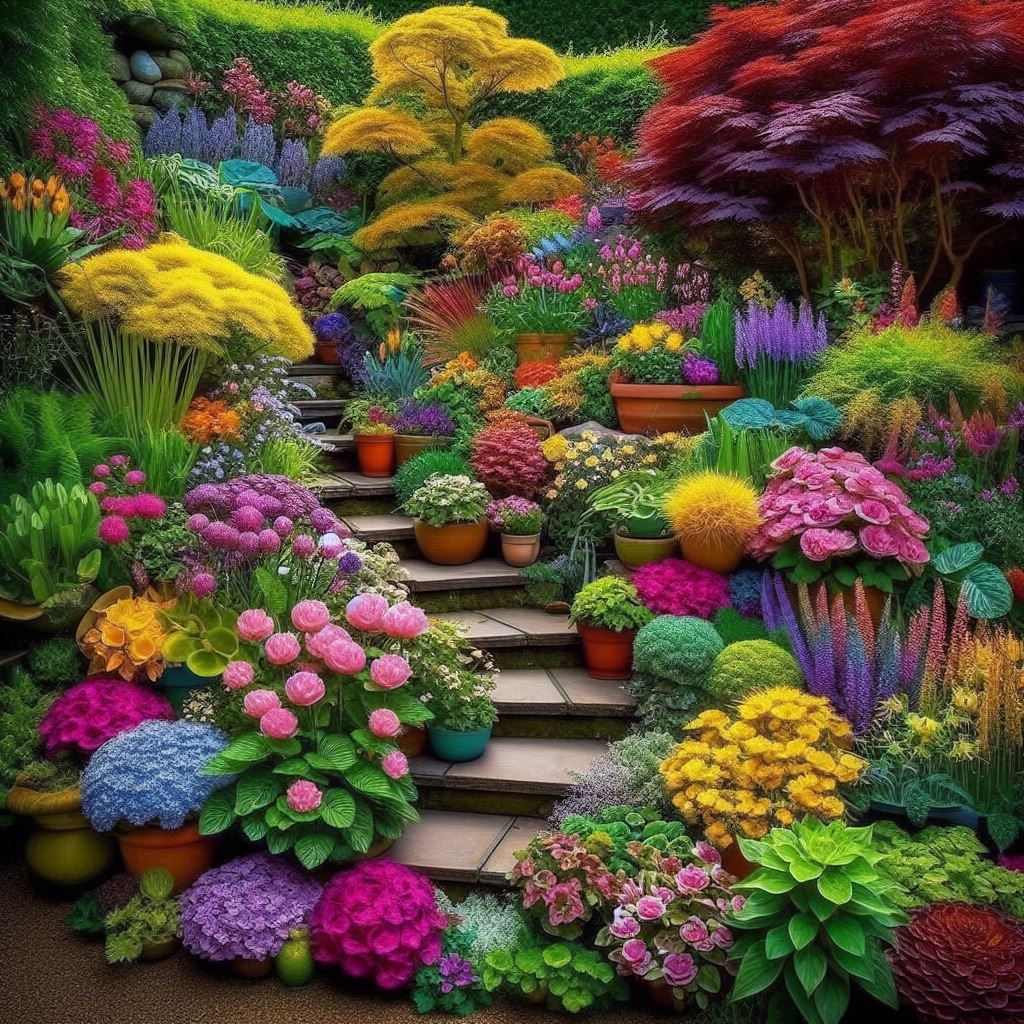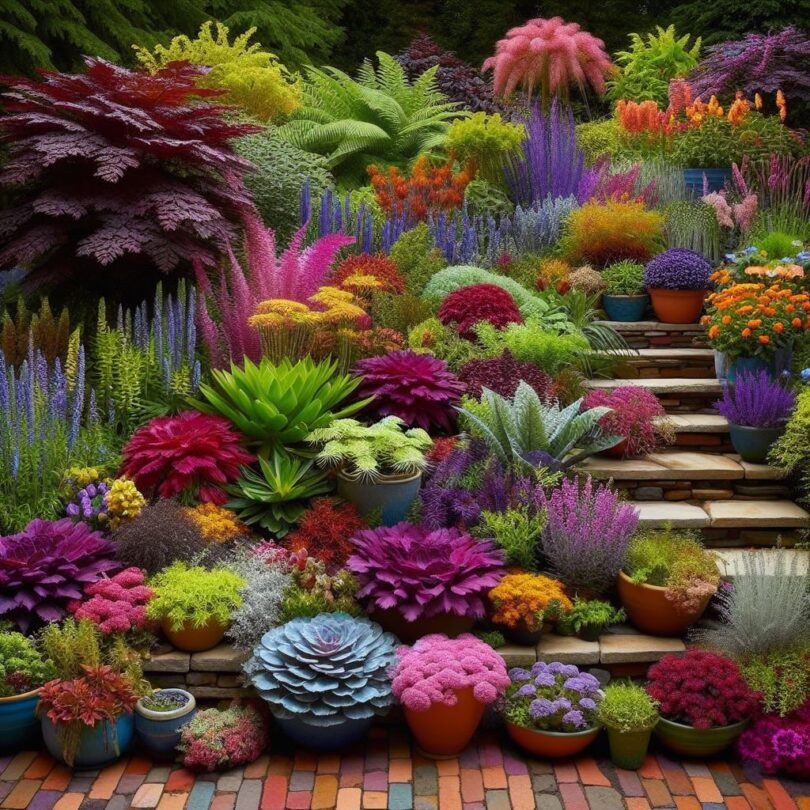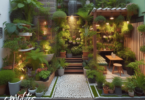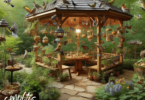Welcome to the world of shade gardening, where vibrant and diverse plant combinations can transform even the shadiest corners into captivating havens of color. Designing a shade garden that flourishes with life and visual interest requires careful consideration of plants that thrive in low-light conditions. But fear not, for this article will guide you through the process of selecting the best shade-loving plants and creating eye-catching color combinations that will make your shade garden a true masterpiece.

Shade gardens hold their own unique charm and present both challenges and benefits to garden enthusiasts. While the diminished sunlight can limit plant options, it also provides an opportunity to explore a range of shade-adapted species that can thrive and bring a touch of magic to your outdoor space. Whether you have a small shaded area or an entire garden in the shadows, this article will equip you with the knowledge and inspiration to create a stunning shade garden.
Key Takeaways:
- Shade gardens can be transformed into vibrant, captivating spaces with carefully chosen plant combinations.
- Assessing the degree of shade and understanding different types of shade is crucial for designing a successful shade garden.
- There is a wide variety of shade-loving plants to choose from, including perennials, annuals, shrubs, and trees.
- Crafting eye-catching color combinations in shade gardens requires an understanding of contrasting and complementary colors, as well as texture variations.
- Creating multi-level shade gardens adds depth and dimension to the landscape and allows for the incorporation of arbors, trellises, and hanging planters.
Understanding Shade: Designing for Optimal Plant Growth
When it comes to landscaping in shade, understanding the different types of shade is essential for designing a successful garden. The amount and quality of light that reaches your plants can greatly influence their growth and overall health. Whether you have a partially shaded garden or a completely shaded yard, careful planning is necessary to create an environment that maximizes the available light and supports optimal plant growth.
Shade can occur in various forms, including dappled shade, filtered shade, and deep shade. Dappled shade occurs when sunlight filters through the foliage of overhead trees, creating patches of light and shadow. Filtered shade is similar, but the sunlight is diffused through a material such as a trellis or light-colored canopy. Deep shade refers to areas with minimal direct sunlight, usually found under dense tree canopies or buildings.
Assessing the degree of shade in your garden is key to determining what types of plants will thrive in your specific conditions. Keep in mind that while many plants require some sunlight to grow, there are also shade-loving plants that can thrive in low-light environments. Designing a shade garden involves selecting plants that are adapted to shade conditions and arranging them in a way that optimizes their access to available light.
When it comes to designing for optimal plant growth in shady gardens, consider the following tips:
- Place taller plants towards the back of a border or in the center of a garden bed to prevent them from shading out smaller plants.
- Use plants with varying levels of shade tolerance to create a layered effect, allowing each plant to receive the amount of light it needs.
- Choose plants with foliage that can brighten up shaded areas, such as those with variegated leaves or striking colors.
- Utilize reflective surfaces, such as light-colored paving stones or strategically placed mirrors, to bounce light back into shaded areas.
- Consider adding trellises or pergolas for shade-loving vines and climbers, creating vertical interest and utilizing the available vertical space.
By carefully considering the type of shade in your garden and implementing these design strategies, you can create a visually appealing and thriving shady garden. Understanding the intricacies of shade and designing with careful consideration for optimal plant growth will ensure that your landscape flourishes even in the absence of direct sunlight.
| Plant | Light Requirements | Growth Habit |
|---|---|---|
| Hosta | Partial to full shade | Clumping |
| Astilbe | Partial shade | Mounding |
| Ferns | Shade to partial shade | Upright, spreading |
| Begonia | Filtered sun to shade | Upright, cascading |
| Hakone Grass | Partial to full shade | Mounding, spreading |
Selecting the Best Plants for Shade Gardens
Shade gardens offer a unique opportunity to cultivate a lush and captivating landscape in areas with limited sunlight. Choosing the right plants is essential to ensure thriving and vibrant gardens. Whether you’re looking to add color with perennials or create structure with trees and shrubs, there are numerous options that excel in shady conditions.
Perennials
Perennials are a popular choice for shade gardens due to their ability to return year after year, providing sustained beauty and interest. When selecting perennials for shade, look for plants with adaptations that allow them to thrive in low-light conditions, such as large, deep-green leaves that can capture as much sunlight as possible. Some top-performing perennials for shade gardens include:
- Astilbe
- Hosta
- Bleeding Heart
- Foamflower
- Lungwort
Annuals
For an instant burst of color and variety, annuals are the go-to choice for shade gardens. These plants complete their life cycle in a single growing season and typically offer a profusion of blooms in a range of colors. When selecting annuals for shade, consider their tolerance for low-light conditions and their ability to withstand cooler temperatures. Some excellent choices for shade-loving annuals include:
- Impatiens
- Begonias
- Tuberous Begonias
- Caladium
- Polka Dot Plant
Shrubs and Trees
Shrubs and trees provide structure, height, and shade in the garden. When choosing shrubs and trees for shade gardens, opt for varieties that can tolerate reduced sunlight levels and have adaptations for shade, such as larger leaves or a more open growth habit. Some noteworthy shade-loving shrubs and trees to consider include:
- Azaleas
- Rhododendrons
- Japanese Maple
- Dogwood
- Holly
Remember, when selecting plants for shade gardens, it’s crucial to consider each plant’s specific light requirements and suitability for the shady conditions in your garden. Taking into account the different types of shade and the specific needs of the plants will help ensure a thriving and visually appealing shade garden.
Crafting Eye-catching Color Combinations
Creating a visually stunning shade garden goes beyond selecting shade-tolerant plants. The art of crafting eye-catching color combinations plays a crucial role in transforming shaded areas into captivating outdoor spaces. By strategically pairing plants with contrasting and complementary colors, incorporating texture variations, and leveraging foliage’s visual interest, you can bring vibrancy and depth to your shade garden.
Contrasting and Complementary Colors
The key to achieving captivating color combinations in shade gardens lies in understanding the principles of contrasting and complementary colors. Contrasting colors, located on opposite sides of the color wheel, create a bold and dynamic effect. Consider pairing purples with yellows, or blues with oranges, to make a striking statement in your shade garden. On the other hand, complementary colors, found opposite each other on the wheel, produce a harmonious and balanced look. Experiment with combinations like red and green or purple and yellow to add a sense of harmony to your shaded oasis.
Texture Variations
Texture variations play an important role in adding visual interest to shade gardens. By combining plants with diverse foliage characteristics, you can create an enticing interplay of textures. Consider pairing delicate ferns with bold, broad-leaved hostas or feathery astilbes with the coarse texture of ornamental grasses. The contrast in leaf shapes, sizes, and surface textures enhances the overall aesthetic appeal of your shade garden and creates a captivating sensory experience.
Emphasizing Foliage
In the absence of abundant sunlight, foliage becomes a central focal point in shade gardens. Take advantage of the wide range of foliage colors and textures available in shade-loving plants. Incorporate plants with variegated leaves, such as caladiums or heucheras, to add splashes of color and visual interest. Additionally, select plants with different leaf shapes and sizes to introduce dimension and create captivating patterns in your shade garden.
When combining plants for eye-catching color schemes in shade gardens, think beyond flowers. The foliage, with its diverse hues, textures, and patterns, can be the star of the show.
| Plant Combination | Contrasting Colors | Texture Variation | Emphasizing Foliage |
|---|---|---|---|
| Hosta + Hakone Grass | Green + Reddish-Brown | Large, Broad Leaves + Fine, Arching Blades | Variegated Leaves + Fine, Arching Blades |
| Astilbe + Heuchera | Pink + Purple | Feathery Plumes + Ruffled Foliage | Green Leaves + Contrasting Purple Leaves |
| Ferns + Caladiums | Green + Various Colors | Delicate Fronds + Large, Bold Leaves | Variegated Leaves + Textured Foliage |
By incorporating a variety of contrasting and complementary colors, texture variations, and foliage-focused plant combinations, you can create eye-catching color schemes that breathe life into your shade garden. Experiment with different combinations and let your creativity flourish as you transform your shaded oasis into a vibrant and enchanting outdoor retreat.
Design Considerations for Multi-Level Shade Gardens
Creating a multi-level shade garden adds depth and dimension to your landscape, transforming it into a captivating outdoor oasis. By utilizing different heights and layers, you can make the most of your shaded areas and create a visually stunning space. Here are some ideas for incorporating various elements into your multi-level shade garden:
Arbors and Trellises
Add interest and verticality to your shade garden by incorporating arbors and trellises. These structures not only create visual focal points but also provide support for climbing plants like ivy, clematis, or wisteria. The intertwining foliage and blooms will add a lush and enchanting aesthetic to your shaded space.
Hanging Planters
Make use of the vertical space in your shade garden by hanging planters from trees, arbor beams, or pergolas. Choose shade-loving plants like ferns, impatiens, or begonias that thrive in elevated conditions. Hanging planters not only add greenery at eye level but also create a cascading effect, enhancing the overall aesthetic of your garden.
Stepping Stones and Pathways
Create a sense of movement and exploration in your multi-level shade garden by incorporating stepping stones and pathways. Position them strategically to guide visitors through different levels and areas of interest. Use materials like gravel, flagstone, or moss to create pathways that blend harmoniously with the natural surroundings.
Water Features
Add a touch of tranquility and serenity to your shaded oasis with the inclusion of water features. Whether it’s a small fountain, a pond, or a babbling brook, the sound and movement of water can create a soothing ambiance. The combination of shade plants, water, and dappled light can create a magical atmosphere in your garden.
Seating Areas
Make your shade garden a comfortable retreat by incorporating seating areas. Arrange benches, chairs, or hammocks in different levels throughout your garden to allow visitors to relax, unwind, and enjoy the peaceful surroundings. Consider placing seating areas in locations that offer the best views of your garden’s diverse plantings.
Lighting
Extend the usability of your shade garden into the evening hours by incorporating lighting elements. Choose soft, warm lights that illuminate key features, such as plants, pathways, or water features. This not only enhances the visual appeal but also creates a cozy and inviting atmosphere, making your shade garden a place to enjoy day and night.
Elements for Multi-Level Shade Gardens
| Elements | Description |
|---|---|
| Arbors and Trellises | Add vertical interest and support climbing plants. |
| Hanging Planters | Elevate shade-loving plants to add cascading beauty. |
| Stepping Stones and Pathways | Create movement and guide visitors through the garden. |
| Water Features | Add tranquility and a touch of magic to the garden. |
| Seating Areas | Provide comfortable spaces to relax and enjoy the garden. |
| Lighting | Extend the usability of the garden into the evening. |
By incorporating elements like arbors, trellises, hanging planters, and pathways, you can create a multi-level shade garden that is both visually stunning and functional. Consider these design considerations and let your creativity flow as you transform your shaded space into an enchanting outdoor retreat.
Nurturing Healthy Shade Gardens: Soil and Maintenance Tips
Creating and maintaining a thriving shade garden requires careful attention to soil preparation, watering techniques, and plant maintenance. By following these essential guidelines, you can ensure the health and vitality of your shade-loving plants and create a lush landscape that thrives in shaded areas.
Soil Preparation for Shade Gardens
Proper soil preparation is crucial for the success of shade gardens. Here are a few key soil considerations:
- Amend the soil: Add organic matter such as compost or well-rotted manure to improve soil structure and fertility.
- Ensure good drainage: Shady areas can be prone to poor drainage, so amend the soil with perlite or vermiculite to improve drainage.
- Test the pH: Most shade plants prefer slightly acidic soil, so test the pH and adjust if necessary using lime or sulfur.
Watering Techniques for Shade Gardens
Proper watering is essential for the health and vitality of shade-loving plants. Consider the following watering techniques:
- Monitor moisture levels: Regularly check the soil moisture levels by inserting your finger into the soil. Water when the top inch feels dry.
- Deep waterings: Provide deep waterings rather than frequent shallow watering to encourage deeper root growth.
- Mulch: Apply a layer of organic mulch around plants to help conserve moisture and regulate soil temperature.
Pruning and Fertilizing Shade-Loving Plants
Proper pruning and fertilizing practices will help keep your shade garden looking its best. Follow these tips:
- Prune for shape and health: Regularly prune shade-loving plants to maintain their shape and remove dead or diseased branches.
- Fertilize appropriately: Use a balanced, slow-release fertilizer formulated for shade plants to provide the necessary nutrients without overstimulating growth.
- Avoid over-fertilizing: Excessive fertilization can lead to weak growth and susceptibility to pests and diseases.
By implementing these soil and maintenance tips, you can create a thriving shade garden that showcases the beauty of shade-loving plants and provides a tranquil retreat in your outdoor space.
Inspiring Examples of Shade Garden Designs
Looking for shade garden ideas? Look no further! This section features a collection of inspiring shade garden designs that will ignite your creativity and help you transform your shady outdoor space into a lush and inviting oasis.
Each of these designs showcases different themes, plant combinations, and special features to add character and charm to your shade garden. Whether you prefer a serene and calming retreat or a vibrant burst of colors, there’s a shade garden design here for everyone.
Let’s explore some of these beautiful examples:
1. Tranquil Zen Retreat
“A shade garden can be a perfect place to create a Zen-inspired retreat. This design incorporates peaceful elements such as a small meditation area surrounded by lush greenery. Bamboo varieties and Japanese maples bring height and texture, while a miniature water feature adds a soothing ambiance.”
2. English Cottage Garden
“Capture the charm of an English cottage garden in the shade. With delicate perennials like foxgloves and columbines, and a mix of climbing roses and flowering vines, this design creates a romantic and magical atmosphere. Stone pathways wind through the garden, leading to cozy seating areas where you can enjoy a cup of tea.”
3. Woodland Wonderland
“Embrace the natural beauty of a woodland setting with this enchanting shade garden design. Ferns, hostas, and mosses create a lush carpet beneath the towering trees, while pops of color from bleeding hearts and astilbes add vibrancy. Bird feeders and birdbaths attract feathered visitors, bringing life and movement to the garden.”
4. Modern Minimalist
“For those who appreciate sleek lines and simplicity, a modern minimalist shade garden design can be the perfect choice. Use architectural plants like fern leaf buckthorn and Japanese forest grass to create a clean and contemporary look. Pops of color can be added with strategic placement of vibrant shade-loving flowers, such as impatiens or begonias.”
These are just a few examples to spark your imagination. Feel free to mix and match ideas from different designs or come up with your own unique shade garden design that reflects your personal style and preferences.
Remember, landscaping in shade offers endless possibilities, and with the right plant combinations, you can create a captivating and thriving garden that will be the envy of all.
Conclusion
Creating a vibrant and inviting shade garden requires careful consideration of plant combinations and landscaping techniques. By understanding the different types of shade and designing with optimal plant growth in mind, you can transform your shaded areas into thriving havens of color and beauty.
When selecting plants for your shade garden, choose varieties that are well-suited to low-light conditions and offer a range of textures and colors. This will allow you to craft eye-catching color combinations that bring visual interest to your garden. Remember to also take advantage of multi-level design options, utilizing different heights and layers to add depth and dimension to your landscape.
Maintaining a healthy shade garden involves proper soil preparation, watering techniques, and regular maintenance. By providing the right conditions for your shade-loving plants to thrive, you can enjoy the beauty of your garden for years to come.
Now armed with inspiration and practical knowledge, you are ready to embark on your own shade gardening project. Experiment with different shade garden ideas, incorporate your favorite plant combinations, and create a tranquil oasis in those shady corners of your outdoor space. So go ahead, let your creativity blossom!
FAQ
What are the best plants for shade gardens?
Some popular shade-loving plants include hostas, ferns, astilbes, heucheras, and hydrangeas. These plants thrive in the lower light conditions of a shade garden and can add vibrant colors, textures, and foliage to the landscape.
How do I design a shade garden that maximizes available light?
When designing a shade garden, it’s important to assess the degree of shade in the area. Consider the angle and intensity of sunlight throughout the day and identify areas of partial or full shade. Opt for plants that can tolerate different levels of shade and strategically arrange them to optimize the available light.
Can I create eye-catching color combinations in a shade garden?
Absolutely! While shade gardens may not receive as much sunlight, you can still create stunning color combinations by choosing plants with contrasting or complementary colors. Experiment with different hues and textures to add depth and visual interest to your shade garden.
How can I add depth and dimension to a shade garden?
To create a multi-level shade garden, consider incorporating different heights and layers. Use taller plants in the back to create a backdrop and arrange shorter plants in front. You can also incorporate arbors, trellises, and hanging planters to add vertical interest and maximize the use of space.
What are some soil and maintenance tips for shade gardens?
For healthy shade gardens, it’s important to prepare the soil properly, ensuring it has good drainage and organic matter. Watering techniques may vary depending on the specific needs of the plants, but it’s generally recommended to water deeply and less frequently. Regular pruning and fertilizing can also help maintain the overall health and appearance of shade-loving plants.
Can you provide some inspiring examples of shade garden designs?
Certainly! Shade gardens offer a wide range of design possibilities. Some inspiring examples include cottage-style shade gardens with a mix of colorful perennials, woodland-inspired gardens with native plants and ferns, or contemporary shade gardens with geometric patterns and minimalistic plant choices. Explore different themes and design styles to find inspiration for your own shade garden.
What should I keep in mind when creating my own shade garden?
When designing your own shade garden, remember to choose plants that are well-suited for the specific lighting conditions of your garden. Consider the height, color, and texture of the plants to create a visually appealing landscape. Take into account maintenance requirements, such as watering and pruning, to ensure the long-term health and vitality of your shade garden.







